Leather is a beautiful and durable material that can last for many years with the right care. However, if you don’t take proper care of it, you may end up with unsightly indentations in your leather furniture or clothing.
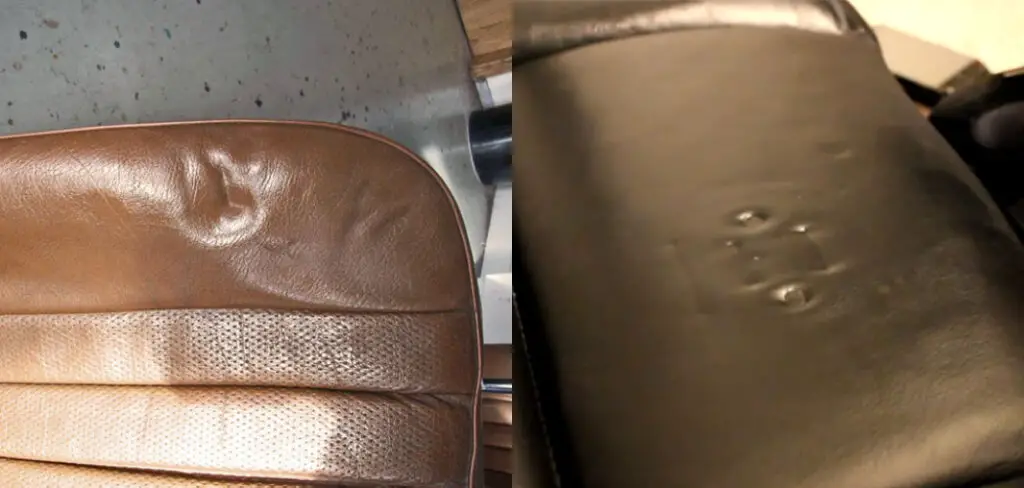
Fortunately, there are several ways to get rid of these indentations and return your leather to its former glory. In this article, we will discuss how to get rid of indentations in leather, as well as some tips on preventing them from happening in the future. So without further ado, let’s get started!
Summary: Indentations in leather are caused by stress and the constant compression of leather over time. To avoid them, use a leather conditioner to protect the leather from drying out and reduce friction that can cause indentations.
If indentations have already formed, fill them using a mixture of water, talcum powder, and glycerin that is massaged into the affected area. Lastly, avoid resting items on top of your leather furnishings for extended periods of time.
What Causes Indentations in Leather?
There are a few different things that can cause indentations in leather. One of the most common is simply leaving something heavy on the leather for an extended period. The object’s weight will cause the leather to sink in and create an indentation. Another common cause is exposure to heat. Placing something hot on leather can cause the material to warp and create an indentation.
Also, improper cleaning and conditioning can lead to indentations, making the leather more susceptible to damage. The other main cause of indentations is worn and tear over time. As leather ages, it can lose its elasticity and become more prone to indentations. Lastly, if your leather is not properly protected from the sun, it can also become faded and cracked, which can lead to indentations.
Why Its Important to Remove Indentations from Leather
Aside from cosmetic reasons, there are a few practical reasons why you’ll want to get rid of indentations in your leather. First, indentations can make it harder to clean and condition your leather properly. If the indentations are deep enough, dirt and grime can get trapped inside them, which can be difficult to remove.
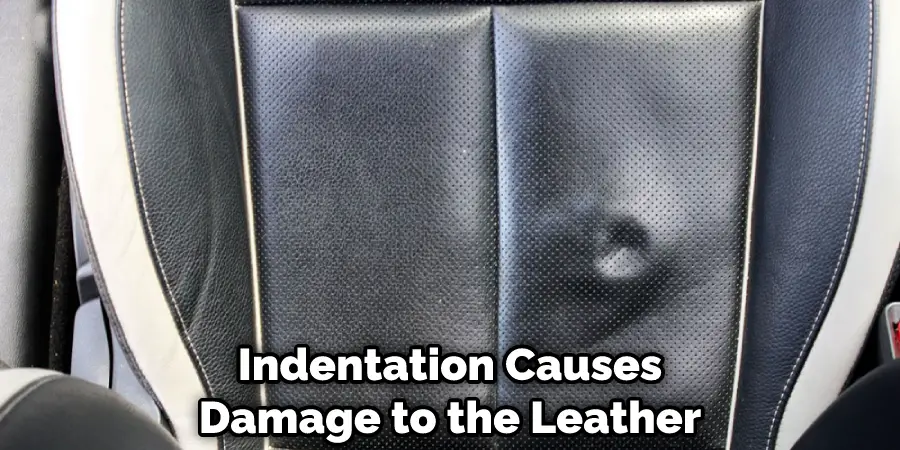
Also, if the indentations are large enough, they can make applying leather cleaner or conditioner difficult. This can lead to an uneven application, which can cause further damage to the leather. Another practical reason to remove indentations is that they can weaken the leather and make it more susceptible to tearing.
Indentations can cause the leather fibers to stretch and break, leading to tears and holes. Finally, indentations can also make applying a finish or polish to your leather harder. If the indentations are deep enough, they can create pockets where the finish or polish will not be able to adhere to the leather properly. Again, this can lead to an uneven and uneven finish.
Some Easy Ways How to Get Rid of Indentations in Leather
1. Use a Hairdryer
One of the quickest and easiest ways to remove indentations in leather is to use a hairdryer. The hairdryer’s heat will help relax the leather fibers and cause the indentations to disappear gradually. Just be sure not to hold the hairdryer too close to the leather, as this can cause the material to warp or discolor.
First, set the hairdryer to the lowest setting and hold it about 6 inches (15 cm) away from the indentations. Then, slowly move the hairdryer back and forth over the area until the indentations begin to disappear. You may need to increase the heat setting if the indentations are deep or stubborn. Just be sure to keep the hairdryer moving so that you don’t overheat the leather.
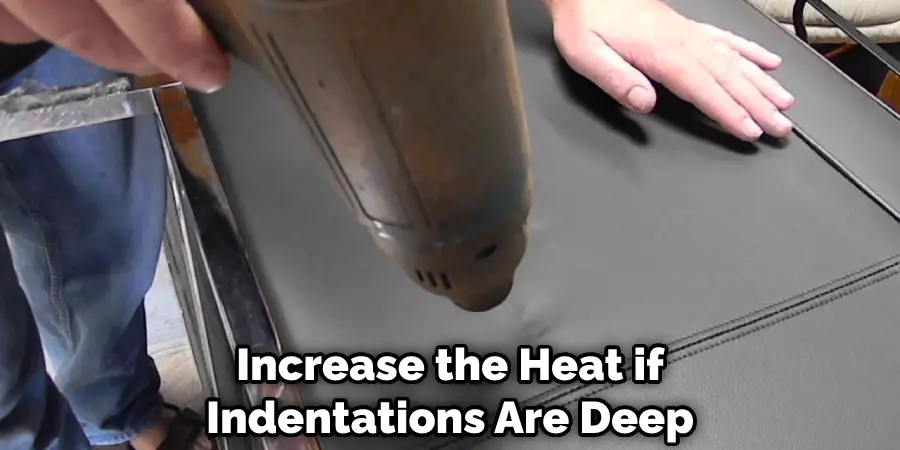
2. Use a Clothes Steamer
Another quick and easy way to remove indentations in leather is to use a clothes steamer. The steamer’s steam will help lift the indentations and make them less visible. Be sure to test the steamer on an inconspicuous area of leather first to ensure it doesn’t damage the material.
First, fill the steamer with water according to the manufacturer’s instructions to use a clothes steamer. Then, hold the steamer a few inches away from the indentations and slowly move it back and forth. Be sure to keep the steamer moving to avoid damaging the leather.
After a few minutes, the indentations should be less visible. If you don’t have a clothes steamer, you can also use a handheld steam iron. Just be sure to use the iron on the lowest setting and hold it a few inches away from the leather to avoid damage.
3. Use a Vacuum Cleaner
If the indentations are shallow, you may be able to remove them with a vacuum cleaner. The vacuum’s suction will help lift the indentations out of the leather. Be sure to use a soft-bristled attachment, so you don’t damage the leather. To vacuum the indentations, start at the center of the mark and work your way outwards in a circular motion. If the indentations are deep, you may need to use a leather conditioner to help fill them in.
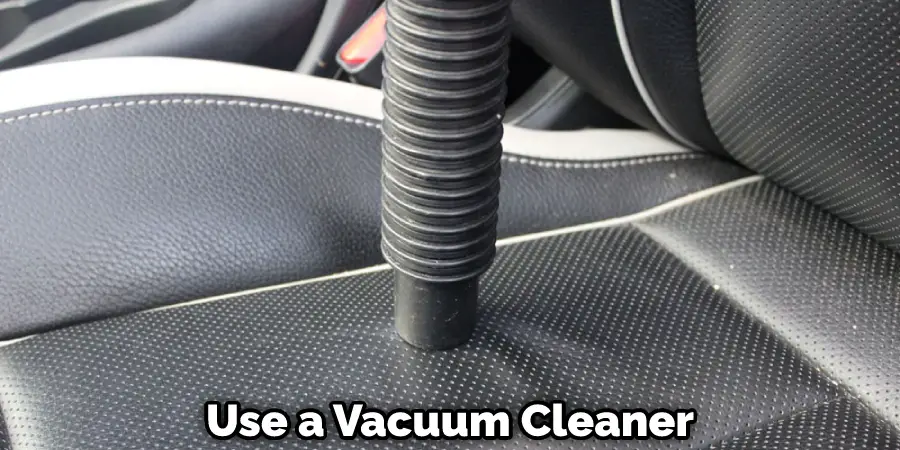
4. Place a Heating Pad
If you have a heating pad, you can use it to remove indentations in leather. The heat will help relax the leather fibers, making the indents less visible. Set the heating pad to a low setting and place it over the area for a few minutes. You can also use a hair dryer on the low setting. Hold it about six inches away from the leather and move it around until the indentations start to disappear.
5. Place a Bowl of Hot Water
Another way to remove indentations is to place a bowl of hot water over the area. Hot water can help to loosen the leather fibers and make them expand, which can help remove the dent. Make sure that the bowl is large enough to cover the entire indentation, and be careful not to burn yourself.
Allow the hot water to sit for several minutes before removing it. First, use a spoon to scoop out the hot water, and then blot the area dry with a towel. You may need to repeat this process a few times to remove the dent completely.
6. Use a Leather Repair Kit
If the indentations are deep or you can’t get them to budge with any of the above methods, you may need to use a leather repair kit. These kits usually come with a leather filler that can be used to fill in the indentations. First, clean the area around the indentations with a leather cleaner.
Then, follow the instructions that come with the kit to fill in the indentations. Once the filler is dry, sand it down so that it’s flush with the rest of the leather. Finally, apply a leather conditioner to keep the area from drying out. If the indentations are still visible, you may need to repeat these steps until they’re no longer noticeable.
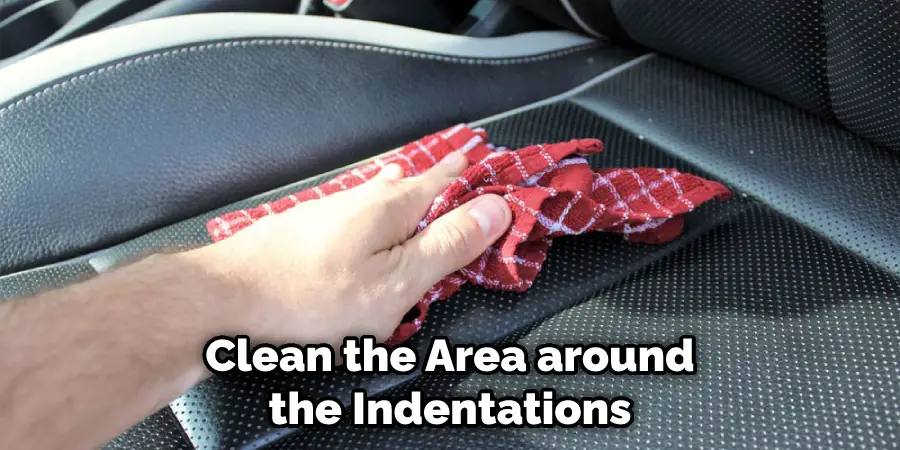
7. Use a Credit Card
If you don’t have a leather repair kit, you can try using a credit card to fill in the indentations. Credit cards are made of a material that is similar to leather so that they can be used as a temporary fix. To use a credit card, first clean the area around the indentation.
Then, take the credit card and slide it into the indentation. Use your finger to press the credit card down into the indentation and allow the area to dry for 24 hours. If the indentation is still visible, you can repeat this process. If the indentation is still visible after a few attempts, you can try using a leather filler. Avoid using anything else to fill in the indentation, as this can damage the leather.
8. Call a Leather Repair Specialist
If you’ve tried all of the above methods and the indentations are still visible, you may need to call a leather repair specialist. They will be able to sand down the area and apply a new finish that will help to cover up the indentations. This is usually a last resort, as it can be expensive. But it may be your only option if you’ve tried everything else and nothing has worked.
The Stretchability of Leather
Leather is a popular material known for its durability and strength. However, it is also known to be quite stretchable, depending on the type and quality of the leather. Stretchability is an important factor to consider when deciding on the type of leather to use in different applications.
One of the reasons leather is so stretchable is because it is a natural material made from animal skins. These skins are constantly in motion, which can lead to them stretching and contracting over time. Additionally, how the leather is processed can also impact its stretchability.
High-quality, genuine leather is typically more stretchable than synthetic leather or cheap imitations. This is because genuine leather is made from organic materials that have a certain level of elasticity. Leather that is tanned correctly can also be more stretchable as it has been treated to prevent it from cracking or breaking.
Tips and Warnings on How to Get Rid of Indentations in Leather
Tips:
- Be sure to test any leather cleaner in an inconspicuous spot first.
- Use a soft, clean cloth when applying the leather cleaner.
- Wipe the area dry after cleaning.
- Repeat steps 2-3 as needed until the indentations are gone.
Warnings:
- Do not use harsh chemicals or abrasives on leather.
- Do not over-clean the area, as this can damage the leather.
- Do not allow the cleaner to dry on the leather.
How Much Does It Cost to Get Rid of Indentations in Leather?
The cost of removing indentations in leather will vary depending on the indentations’ depth and the area’s size. If you need to call a leather repair specialist, the cost can be as high as $200. However, if the indentations are shallow and you’re able to remove them yourself, the cost will be much lower. Removing indentations in leather should cost between $50 and $100. This includes the cost of the leather cleaner, repair kit, and conditioner.
How To Remove Dents & Creases From Seats?
Removing dents and creases from the seats of your car can be a daunting task. However, it is possible to do it successfully with the right tools and methods. One approach is to use a vacuum cleaner to suck out the air from the dent or crease. Start by placing the vacuum at the center of the mark, then turn it on and let it run for a few minutes. This can help to pull the seat back into shape gradually.
Another approach is to use a clothes iron and a damp cloth. Start by dampening the cloth and placing it over the affected area. Then use the iron to heat up the cloth, being careful not to get the iron in direct contact with the seat. This helps to soften the material and allows the pressure to release some of the dents and creases.
Using a heat gun could be another approach. Start by heating the affected area with the heat gun, then use a soft cloth to massage the material back into shape. The heat helps to loosen up the fibers, making them more pliable and easier to work with.
Frequently Asked Questions
Can You Repair Dented Leather?
Leather is a durable material, but it can be damaged if it is not treated properly. If your leather item has been dented, there are many ways to repair it. You can use a hair dryer to heat up the area and push the dent out. You can also use a vacuum cleaner to suck out the dent and then seal it with a adhesive.
How Do You Fix Nicks in Leather?
There are a few different ways to fix nicks in leather, depending on the severity of the nick and the materials used. If the nick is small and does not affect the overall appearance or function of the leather item, a simple solution may be to use a cream or liquid leather restorer to fill in the hole. If the nick is larger or more visible, it may be necessary to replace the entire section of leather that has been damaged. In either case, it is important to make sure that the repair is done correctly so that the integrity of the leather is not compromised.
Is Magic Eraser Good for Leather Seats?
It depends on the type of leather seat and the specific care instructions for that type of leather seat. In general, using a Magic Eraser on a leather seat may be effective in removing dirt, dust, and surface stains, but it is not recommended for removing deep marks or damage. It is also important to not
Will Hydrogen Peroxide Damage Leather?
Leather is a durable material, but like all materials it can be damaged by certain substances. Hydrogen peroxide is a common household cleaner and disinfectant that is often used to clean surfaces such as leather. While hydrogen peroxide can damage leather if it is applied too heavily or if it is left on the surface for an extended period of time, it is generally safe to use on leather in small amounts.
Conclusion
So there you have it! How to Get Rid of Indentations in Leather. By following the steps above, you should be able to remove the indentations and get your leather furniture looking like new again! We hope this guide was helpful and that you’re now on your way to indentation-free leather!

